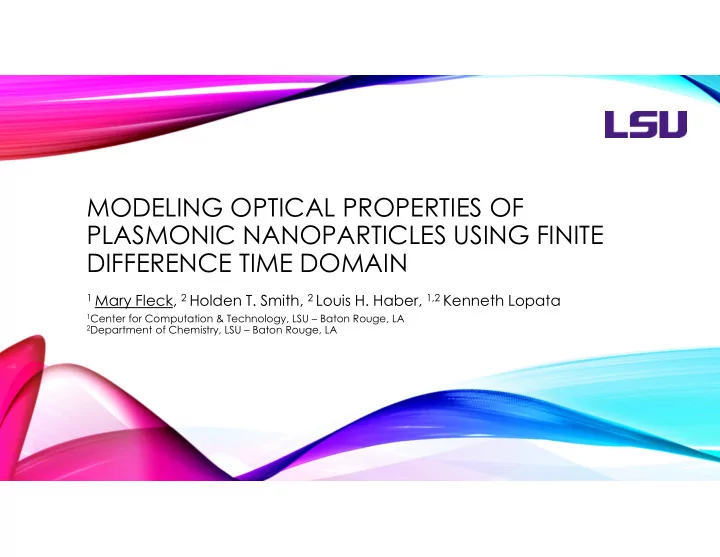

MODELING OPTICAL PROPERTIES OF PLASMONIC NANOPARTICLES USING FINITE DIFFERENCE TIME DOMAIN 1 Mary Fleck, 2 Holden T. Smith, 2 Louis H. Haber, 1,2 Kenneth Lopata 1 Center for Computation & Technology, LSU – Baton Rouge, LA 2 Department of Chemistry, LSU – Baton Rouge, LA
LIGHT & MATTER The way that light interacts with metal nanostructures • Light: electromagnetic radiation • Metals: good conductors, lots of electrons that are free to move • Electrons: Motion is affected by other electromagnetic fields • When light meets electrons in metal nanoparticles, electron density rapidly oscillates Plasma oscillations, plasmonic nanoparticles 2
PLASMONIC NANOPARTICLES Localized surface plasmon resonances characterized by the coherent oscillations of free electrons of the metal. Plasmonic nanoparticle are of great interest for applications such as: • Molecular Sensing • Catalysis • Solar Cells |E(w)| 2 • Photothermal Cancer Therapy Field enhancement = ----------- |E 0 (w)| 2 Cobley, C.; Chen, J.; Cho, E. C.; Wang, L. V.; Xia, Y.; Chem. Soc. Rev. 2011, 40, 44. 3 Plech, A.; Kotaidis, V.; Lorenc M.; Boneberg J.; Nature Physics 2006 , 2 , 44.
OVERVIEW Core-shell nanoparticles composed of silver and gold This material is based upon • Gold and silver nanoparticle surfaces are very experiments conducted by attractive for biological applications collaborators of the Louis H. Haber • Nanoparticles with CSS structure have more group at the Louisiana State flexible optical properties University Department of Chemistry. • Create significant plasmonic enhancements when exposed to a variety of wavelengths of light I sought to: GOALS Use FDTD to model extinction and compare with experimental data • Identify plasmon modes involved • Use FDTD code to compute field enhancements • Optimize enhancement by tuning optical properties • Use data from experiments to generate electrodynamic simulations • 4
CLASSICAL TREATMENT Maxwell’s Equations 𝜖𝐹(𝑠, 𝑢) = 1 𝜁 𝛼 × 𝐼 − 1 𝜖𝐾(𝑠, 𝑢) 𝜖𝑢 𝜁 𝜖𝑢 𝜖𝐼(𝑠, 𝑢) = − 1 𝜈 𝛼 × 𝐹 𝜖𝑢 • Large size of Nanoparticles allows for a classical treatment • Computationally cheaper • Finite Difference Time Domain (FDTD) • Approximates the Electromagnetic Field in both time and space. 5
CORE-SHELL-SHELL NANOPARTICLES Concentric metallic gold and silver shells • encapsulating a metallic gold core Gold nanoparticle surfaces are very attractive • for biological applications due to their ability for size-controlled synthesis, stabilization, functionalization, and bio-compatibility. Gold-silver-gold core-shell-shell nanoparticles • can be easily thiolated and functionalized for potential biochemical applications. Karam et. al, J. Phys. Chem. C (2015), 119 (32), 18573-18580 6
GOLD SEEDS AND GOLD-SILVER CORE-SHELL NANOPARTICLES 12 nm Au nanoparticles 12nm gold nanoparticle Au-Ag Core-Shell nanoparticle with 7 12nm Au Core and 12nm Ag Shell Karam et. al, J. Phys. Chem. C (2015), 119 (32), 18573-18580
CORE-SHELL-SHELL: VARYING WIDTH OF SHELLS 20 nm Core-shell-shell nanoparticles with 12 nm gold cores, 12 nm silver shells, and gold shells of 15 nm (top left), 20 nm (top right), and 30 nm (bottom right) 8 Karam et. al, J. Phys. Chem. C (2015), 119 (32), 18573-18580
PHOTOTHERMAL CANCER THERAPY Core-shell-shell nanoparticles have 12 nm gold cores, 13 nm silver shells, and 30 nm gold shells Temperature change after irradiation with a 1.7 W defocused laser pulse centered at 800 nm. 9 Karam et. al, J. Phys. Chem. C (2015), 119 (32), 18573-18580
MY CONTRIBUTION Use FDTD to model extinction and compare with experimental data Identify plasmon modes involved Use FDTD code to compute field enhancements • Optimize enhancement by tuning optical properties • Use data from experiments to generate electrodynamic simulations Timeline Silver-Gold Silver Nanoparticle Silver-Gold Analysis and Core-Shell Plasmonics Core-Shell Analysis Reflection Plasmonics 10
SILVER NANOPARTICLES Extinction and field enhancement well-known Ag 11
SILVER-GOLD CORE-SHELL NANOPARTICLES • Not so simple: • Need for convergence on all parameters according to Mie theory • Need for analysis of size distribution 12
13
14
FUTURE WORK Extension of core-shell work to Ag-Au-Ag core-shell-shell • Extinction • Field Enhancement 15
Acknowledgements This material is based upon work supported Prof. Kenneth Lopata • by the National Science Foundation under Holden T. Smith • award OCI-1560410 with additional support Prof. Louis Haber • from the Center for Computation & Technology at Louisiana State University. 16
QUESTIONS? Thanks for listening!
Recommend
More recommend